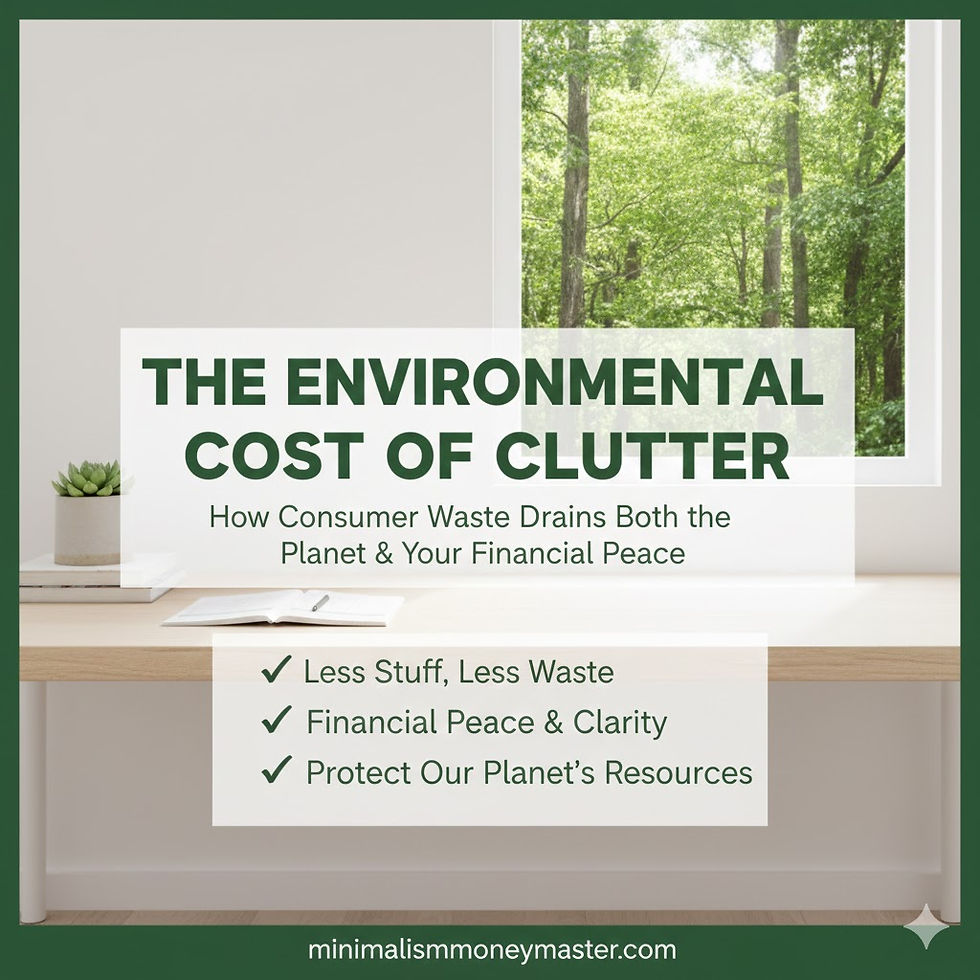Digital Decluttering: A Minimalist’s Guide to Your Digital Legacy
- jennifercorkum
- Sep 8
- 4 min read
In today’s hyperconnected world, we’re drowning in digital possessions — from old emails and unused apps to financial accounts scattered across multiple platforms. Yet, while we declutter our homes and simplify our lifestyles, many of us overlook the chaos lurking in our digital lives.
Here’s the truth: your digital legacy matters just as much as your physical one. Without a plan, your online accounts, assets, and data can become a burden for your loved ones or a target for hackers. As a minimalist, your goal isn’t just to simplify life today — it’s to leave behind an intentional, secure, and streamlined digital footprint.
This guide will show you how to declutter your digital estate using a minimalist finance mindset, protect your assets, and ensure your loved ones are spared unnecessary complexity.
The Minimalist Finance Mindset
Minimalism is more than reducing clutter — it’s about intentional living. Applied to your digital and financial life, it means focusing on what truly matters, eliminating the unnecessary, and securing what’s left.
Every forgotten social media profile, unused banking app, or dormant email account is a potential vulnerability. Hackers exploit inactive accounts, and your heirs may not even know they exist. A minimalist digital strategy removes this noise and prioritizes:
Simplicity: Keep only what adds value.
Security: Reduce exposure to risks.
Clarity: Make your legacy effortless to manage.
In finance, fewer accounts mean fewer moving parts — and fewer headaches for the people you leave behind.
Step 1: Take Inventory of Your Digital Assets
Before you simplify, you need a clear picture of what you own digitally. Make a digital inventory and ask two key questions for each asset:
Does this have financial or sentimental value?
Examples: investment accounts, crypto wallets, PayPal balances, YouTube channels, or cherished photo libraries.
Does it pose a security or privacy risk?
Examples: old email addresses, unused shopping accounts, and inactive social media profiles.
Keep, secure, or delete. If an account has no value and introduces unnecessary risk, close it. Fewer accounts mean a stronger security posture and a leaner digital footprint.
Step 2: Streamline Social Media & Communication Accounts
Social media platforms have become digital graveyards of forgotten logins. Fortunately, most major platforms — including Google, Apple, and Meta — now offer legacy contact features or inactive account managers.
Facebook: Decide whether to memorialize or delete your account and assign someone to manage it.
Apple: Use the Legacy Contact feature to grant access to your data securely.
Google: Set up an Inactive Account Manager to control what happens to Gmail, Drive, and other services.
A minimalist sets this up once and moves on, confident their online identity won’t become a liability.
Step 3: Simplify Your Financial Accounts
In our paperless banking era, heirs often struggle to track down financial assets. Avoid leaving them in the dark by:
Listing all financial accounts — banks, brokerages, credit cards, and digital payment apps like Venmo, PayPal, and Cash App.
Documenting recurring bills tied to those accounts.
Updating beneficiary designations on investment, retirement, and savings accounts.
For minimalists, this is the ultimate win: your assets bypass probate, avoiding costly legal delays and providing peace of mind for your family.
Step 4: Secure Cryptocurrencies and NFTs
Crypto wallets and NFTs can represent significant value, but they introduce unique estate planning challenges. Without your private key, these assets are lost forever.
A minimalist approach:
Store your wallet keys and NFT metadata on an encrypted USB drive.
Place it in a fireproof safe or bank safe-deposit box.
Document its location in your estate plan and ensure a trusted person knows how to access it.
This simple, low-tech storage solution aligns with a minimalist framework while safeguarding cutting-edge digital assets.
Step 5: Include Intellectual Property
For creators, freelancers, and entrepreneurs, digital intellectual property — such as YouTube ad revenue, podcast royalties, or online courses — can generate ongoing income.
Don’t leave these assets in limbo. In your estate plan, clearly state:
Who inherits your IP.
How it should be managed.
Any revenue-sharing expectations.
A minimalist plan ensures your hard work continues to benefit the people and causes you care about.
Step 6: Consolidate for Security
Minimalists know that less equals safer. Every extra account, app, and login is another potential attack surface for hackers. Here’s how to tighten security:
Close outdated accounts — especially old email addresses.
Consolidate financial accounts into one or two main hubs.
Delete redundant apps that no longer serve a purpose.
Reducing the clutter shrinks your digital footprint and fortifies your defenses.
Step 7: Use a Password Manager
One of the simplest ways to improve security is by using a password manager. These tools:
Encrypt and store all your passwords in a single secure vault.
Offer built-in legacy access features for trusted contacts.
Eliminate the need for sticky notes, spreadsheets, or scattered password lists.
For minimalists, this is the ultimate win-win: simplicity plus security.
Step 8: Back Up Your Digital Life
Even a minimalist digital footprint needs protection from loss. Avoid relying solely on cloud services, which are vulnerable to outages or cyberattacks.
Regularly back up key documents and photos to a physical hard drive.
Store backups securely alongside your estate documents.
Think of this as your digital safety deposit box — one secure, intentional copy of everything that matters.
Step 9: Write Your “I Love You” Letter
Finally, simplify everything for your loved ones by preparing an “I Love You” letter — a concise, non-legal document that complements your will and trusts.
Include:
A list of all digital and financial accounts.
The location of your password manager’s master key.
Access details for backups, crypto wallets, and IP.
Instructions for memorializing or deleting online accounts.
Contact information for your financial advisor, lawyer, or executor.
This single document becomes a gift of clarity during a difficult time, ensuring your family isn’t left searching for answers.
Final Thoughts: Minimalism is Legacy
Digital decluttering isn’t about deleting everything — it’s about intentional curation. By simplifying your digital life today, you create a secure, manageable, and meaningful digital legacy for tomorrow.
With a minimalist finance mindset, you reduce chaos, increase security, and give your loved ones something priceless: clarity.







Comments